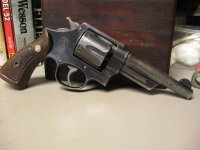It was tumultuous time for S&W with the new short action guns as Miller said and the new plant as Charlie said.
The new plant had only been completed in August, 1949, and S&W built it themselves. It is built in a 126 acre swamp that was filled with 1.1 million yards of dirt to raise the level 15 feet!
S&W did not hire architects or engineers because they could not afford them. There was not a general contractor per se: S&W built the plant with daywork labor provided by the Carlson Company. They paid as they went and obtained NO financing.

Their machinery and tooling was worn out and over two thousand machines had to be converted from belt drive to individual motors!
Meanwhile, the entire product line was being modernized with short actions, and ribs and micro click sights were added to all Target guns.
Let's summarize that period from VJ day to just about exactly four years later in Aug, 1949:
1- Filled a 126 acre swamp with over a million yards of dirt.
2- Built a 350,000 square foot plant with NO financing, no architects, and no outside engineering.
3- Converted over 2000 machines to run with motors instead of belt drive.
4- Modernized the entire product line and developed the Masterpiece lines, the 1950 N frames, and the J frame was in progress.
5- and still produced hundreds of thousands guns.
I think they were doing rather well! 
There is no doubt in my mind that all this was only accomplished because of the leadership of Carl Hellstrom. Obviously a productive and truly amazing man. I wish I could have known him. I would especially liked to have had a few drinks with him.

True, the 357 Mag was a major milestone in handgun development.
True, the production achieved during WW II was astounding.
BUT, the models developed and produced between 1945 and 1955 set the standard that we still judge handguns by and, IMO, will never be surpassed.
On Miller's statement in this article, I'm kind of the opinion that he just more or less provided a copy of what the company had been saying since the War had ended.
I know he was assistant sales manager, but that just means his native tongue is "salesman". He ain't ever gonna be happy if there are not not trucks loaded with product ready to roll the next time he gets off the phone.

I think Hellstrom would have provided a much more positive view if he had been called upon.

Just to nitpick Miller a little more, this really caught my attention-
REALLY?
You guys help me out here-
Show me your Post War Transition 44-2nd Model Military*.
I'd really like to see your Post War Transition 44-2nd Model Target*.
While your digging them out, be sure and show us your Post War Transition 32 and 38 Safeties*. I really wanna see em. 
*and yes, I know the 44-2nd was replaced in the 1941 catalog with the Model 1926 and only the 38 Safety is shown in the 1941 catalog, but I seriously doubt the 41 catalog ever got widely distributed because all civilian production was suspended after Dunkirk in May-June, 1940.








